通俗易懂了解Vue组件的生命周期
1.前言
在使用vue2.0进行日常开发中,我们总有这样的需求,我就想在页面刚一加载出这个表格组件时就发送请求去后台拉取数据,亦或者我想在组件加载前显示个loading图,当组件加载出来就让这个loading图消失等等这样或那样的需求,要实现这些需求,最重要的一点就是我怎么知道这个组件什么时候加载,换句话说我该什么时候向后台发送请求,为了解决这种问题,组件的生命周期钩子函数就应运而生,博主自己作为一个vue2.0的初学者,以自己对vue2.0的组件生命周期的理解,力求以最通俗易懂的语言剖析vue2.0组件生命周期的各个过程,如有理解上的差错,还请大佬们不吝赐教,话不多说,现在开始。
2.生命周期图示
首先给出官方文档上的组件生命周期过程图示:
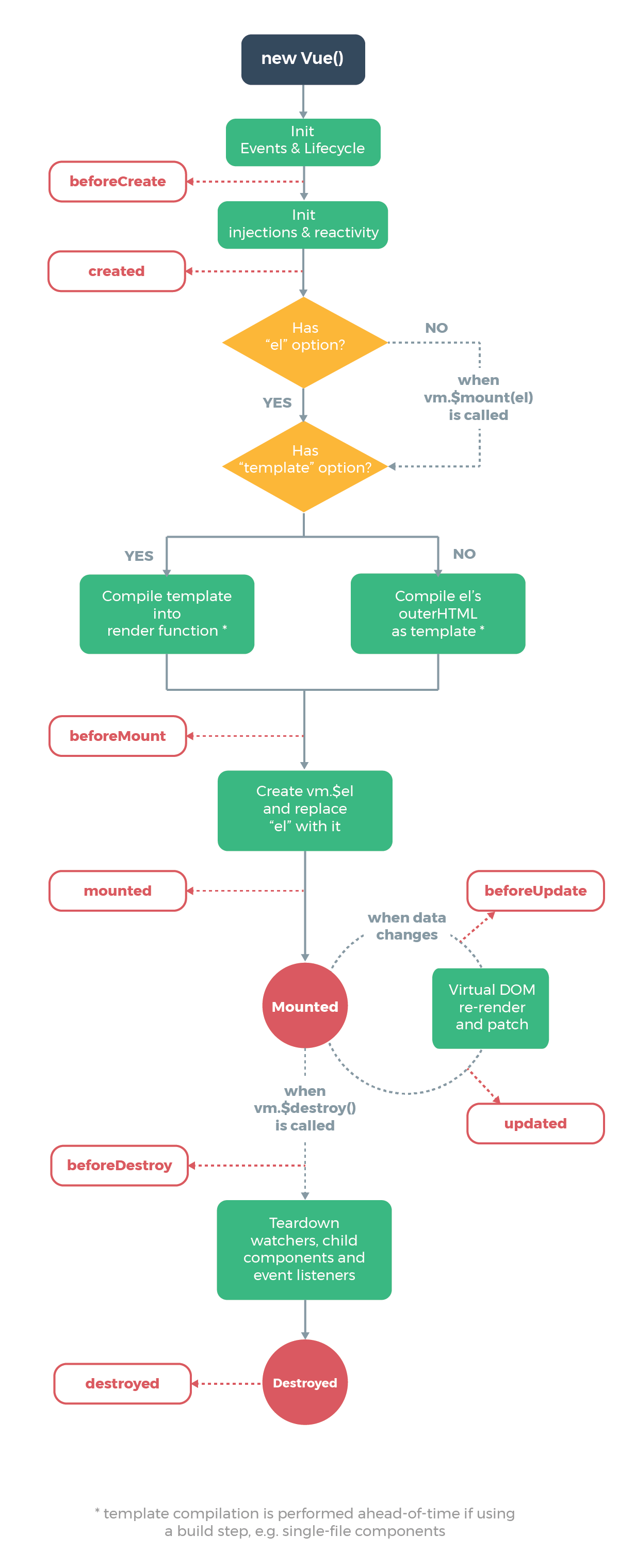
这是官方文档给出的一个组件从被创建出来到最后被销毁所要经历的一系列过程,所以这个过程也叫做一个组件的生命周期图。从图中我们可以看到,一个组件从被创建到最后被销毁,总共要经历以下8个过程:
- beforeCreate:组件创建之前
- created:组件创建完毕
- beforeMount:组件挂载之前
- mounted:组件挂载完毕
- beforeUpate:组件更新之前
- upated:组件更新完毕
- beforeDestoy:组件销毁之前
- destoyed:组件销毁完毕
3.代码演示
了解了组件生命周期各个过程后,我们放一波代码,真正的看一看一个组件从生到死到底经历了什么。
<!DOCTYPE html>
<html lang="en">
<head>
<meta charset="UTF-8">
<title>Title</title>
</head>
<body>
<div id="app">
<h1>{{ message }}</h1>
</div>
<script src="vue.js"></script>
<script type="text/javascript">
var app = new Vue({
el: '#app',
data: {
message : "难凉热血——通俗易懂了解Vue2.0生命周期"
},
//组件创建之前
beforeCreate(){
console.group('beforeCreate 组件创建之前状态===============》');
console.log("%c%s", "color:red" , "el : " + this.$el);
console.log("%c%s", "color:red","data : " + this.$data);
console.log("%c%s", "color:red","message: " + this.message)
},
//组件创建完毕
created(){
console.group('created 组件创建完毕状态===============》');
console.log("%c%s", "color:red","el : " + this.$el);
console.log("%c%s", "color:red","data : " + this.$data);
console.log("%c%s", "color:red","message: " + this.message);
},
// 组件挂载之前
beforeMount(){
console.group('beforeMount 组件挂载之前状态===============》');
console.log("%c%s", "color:red","el : " + (this.$el));
console.log(this.$el);
console.log("%c%s", "color:red","data : " + this.$data);
console.log("%c%s", "color:red","message: " + this.message);
},
// 组件挂载完毕
mounted(){
console.group('mounted 组件挂载完毕状态===============》');
console.log("%c%s", "color:red","el : " + this.$el);
console.log(this.$el);
console.log("%c%s", "color:red","data : " + this.$data);
console.log("%c%s", "color:red","message: " + this.message);
},
// 组件更新之前
beforeUpdate(){
console.group('beforeUpdate 组件更新之前状态===============》');
console.log("%c%s", "color:red","el : " + this.$el);
console.log(this.$el);
console.log("%c%s", "color:red","data : " + this.$data);
console.log("%c%s", "color:red","message: " + this.message);
},
// 组件更新完毕
updated(){
console.group('updated 组件更新完毕状态===============》');
console.log("%c%s", "color:red","el : " + this.$el);
console.log(this.$el);
console.log("%c%s", "color:red","data : " + this.$data);
console.log("%c%s", "color:red","message: " + this.message);
},
// 组件销毁之前
beforeDestroy(){
console.group('beforeDestroy 组件销毁之前状态===============》');
console.log("%c%s", "color:red","el : " + this.$el);
console.log(this.$el);
console.log("%c%s", "color:red","data : " + this.$data);
console.log("%c%s", "color:red","message: " + this.message);
},
// 组件销毁完毕
destroyed(){
console.group('destroyed 组件销毁完毕状态===============》');
console.log("%c%s", "color:red","el : " + this.$el);
console.log(this.$el);
console.log("%c%s", "color:red","data : " + this.$data);
console.log("%c%s", "color:red","message: " + this.message)
}
})
</script>
</body>
</html>
运行上面代码,我们在控制台中可以看到:
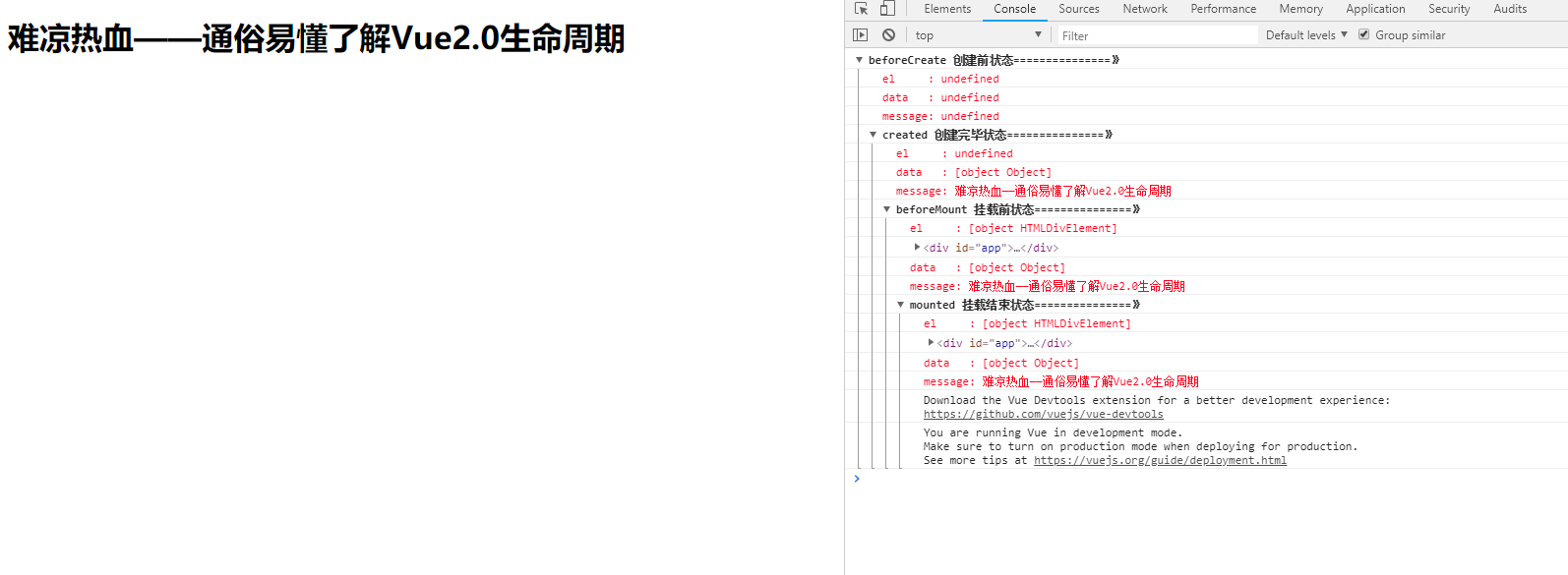
4.各个过程详解
4.1 beforeCreate和created
针对组件创建之前和组件创建完毕这两个过程,我们从控制台打印的结果中可以看出:
在组件创建之前beforeCreate:组件的el和data都未被创建。
在组件创建完毕后created:组件的数据data已经被创建好,但是el还处于未被创建状态。
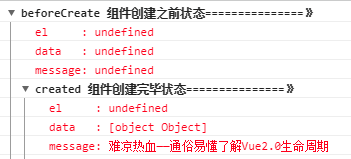
4.2 beforeMount和mounted
针对组件挂载之前和组件挂载完毕这两个过程,我们从控制台打印的结果中可以看出:
在组件挂载之前beforeMount:组件的el就会被创建,但是值得注意的是:虽然数据data里的message早已经被创建好,但是它还未被应用到真是的DOM元素中。
在组件挂载完毕mounted:组件的el,data都已经全部被创建好,并且data里的message也已经被正确的应用到DOM元素中。
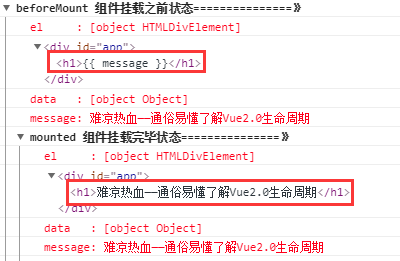
4.3 beforeUpdate和updated
针对组件更新之前和组件更新完毕这两个过程,我们向控制台中输入以下一行代码:
app.message="十年饮冰,难凉热血"
接着,页面和控制台会变成如下样子:
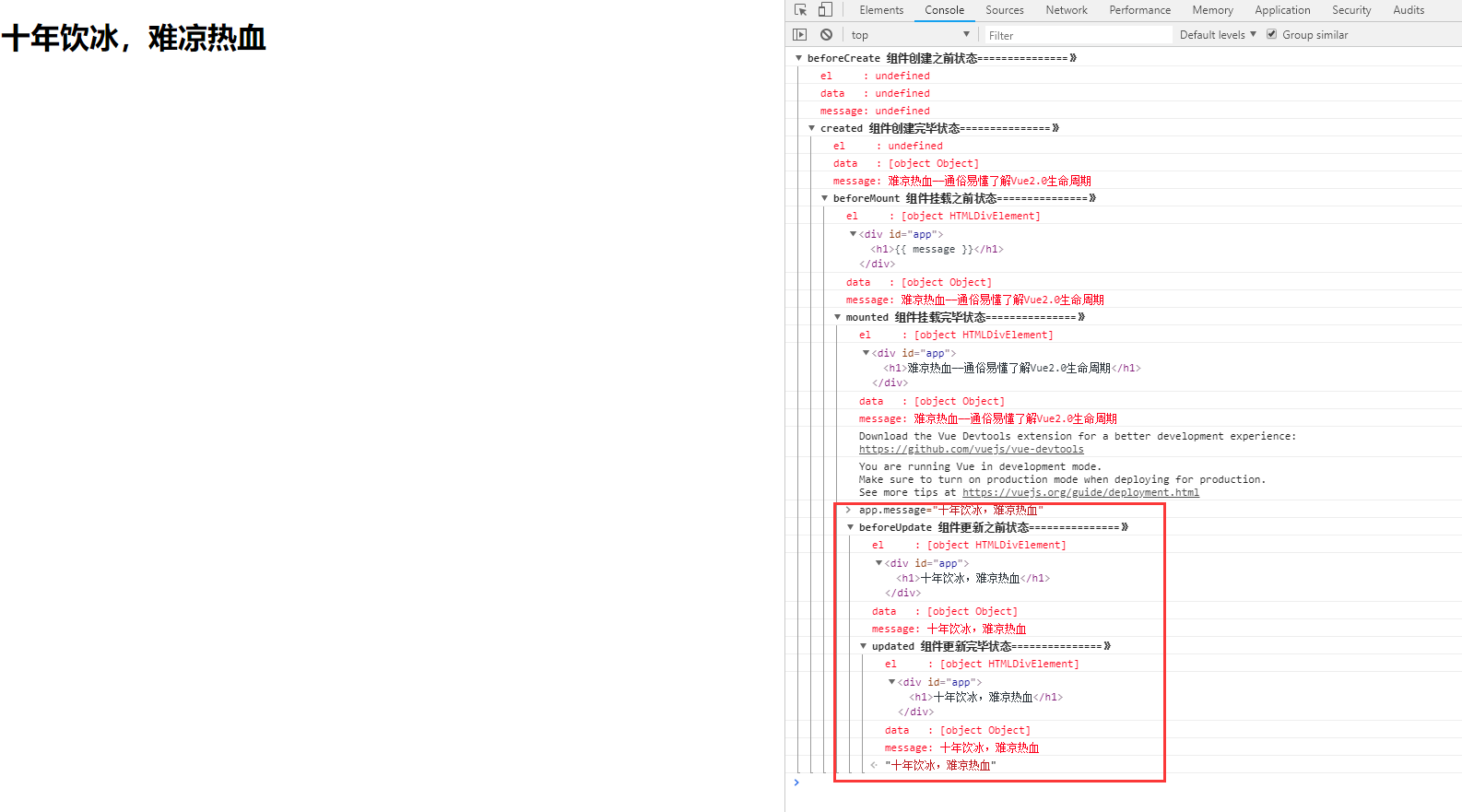
从图中我们可以看到,当我们将data里的message值改变之后,会触发组件的beforeUpdate和update钩子函数。
4.4 beforeDestroy和destroyed
针对组件销毁之前和组件销毁完毕这两个过程,我们向控制台中输入以下一行代码:
app.$destroy();
输入之后并回车,控制台发生了如下变化:

到此之后,整个组件便走完了自己的一生,从创建到被销毁,销毁之后,此时该组件将不再受vue管理,组件上的所有事件监听都会被移除,所以指令都会被解绑。
如若不信,我们再执行以下一行代码,试试再改变一下message的值,看看页面还会不会有什么变化:
app.message="组件真的被销毁了吗?"
执行结果如图:
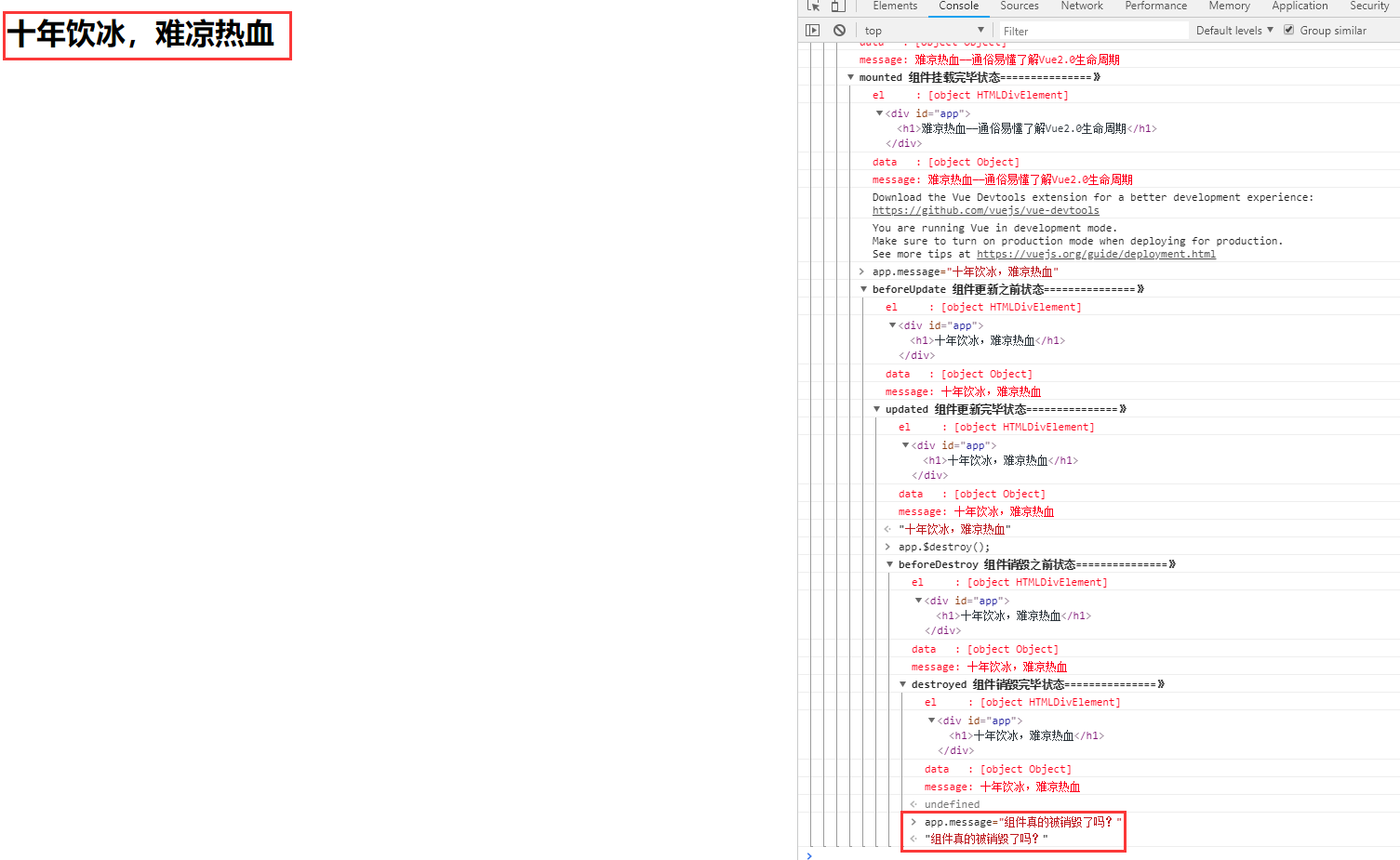
从图中我们可以看到,当组件被销毁之后,再怎么对组件进行操作已经全然无用了。
5.总结
以上就是vue2.0中组件生命周期钩子函数执行的各个过程以及执行的时机,但是这些钩子函数到底该怎么用呢?针对前言中提出的需求我们又该怎么解决呢?在这里,给大家举个例子:
例如有一个表格组件:
1.我们想在表格加载之前显示个loading图,那么我们可以在组件创建之前的钩子函数beforeCreate里面将loading图显示。
2.当组件加载出来,我们可以在created钩子函数里让这个loading图消失。
3.当表格被加载好之后我们想让它马上去拉取后台数据,那么我们可以在组件挂载之前的钩子函数beforeMount里面去发送请求。
。。。
6.遗留问题
针对官方文档中的组件生命周期流程图中的这一部分(下图所示),在上文中我们没有说明,有的同学还有一些疑问,我们在这里统一说明一下:
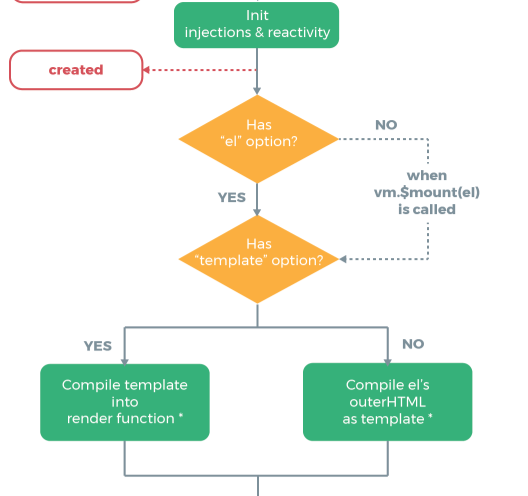
在组件创建之后created和组件被挂载之前beforeMount这期间,发生的事情还是蛮多的,我们一步一步分析一下:
6.1 是否有el选项
当组件被创建之后,vue首先会去查看vue实例(一个组件就是一个vue实例)内是否有el选项。如果有,则正常往下进行,那如果没有呢?我们来做做实验,看如下代码:
<!DOCTYPE html>
<html lang="en">
<head>
<meta charset="UTF-8">
<title>Title</title>
</head>
<body>
<div id="app">
<h1>{{ message }}</h1>
</div>
<script src="vue.js"></script>
<script type="text/javascript">
var app = new Vue({
// el: '#app',
data: {
message : "难凉热血——通俗易懂了解Vue2.0生命周期"
},
//组件创建之前
beforeCreate(){
console.group('beforeCreate 组件创建之前状态===============》');
console.log("%c%s", "color:red" , "el : " + this.$el);
console.log("%c%s", "color:red","data : " + this.$data);
console.log("%c%s", "color:red","message: " + this.message)
},
//组件创建完毕
created(){
console.group('created 组件创建完毕状态===============》');
console.log("%c%s", "color:red","el : " + this.$el);
console.log("%c%s", "color:red","data : " + this.$data);
console.log("%c%s", "color:red","message: " + this.message);
},
// 组件挂载之前
beforeMount(){
console.group('beforeMount 组件挂载之前状态===============》');
console.log("%c%s", "color:red","el : " + (this.$el));
console.log(this.$el);
console.log("%c%s", "color:red","data : " + this.$data);
console.log("%c%s", "color:red","message: " + this.message);
},
// 组件挂载完毕
mounted(){
console.group('mounted 组件挂载完毕状态===============》');
console.log("%c%s", "color:red","el : " + this.$el);
console.log(this.$el);
console.log("%c%s", "color:red","data : " + this.$data);
console.log("%c%s", "color:red","message: " + this.message);
},
// 组件更新之前
beforeUpdate(){
console.group('beforeUpdate 组件更新之前状态===============》');
console.log("%c%s", "color:red","el : " + this.$el);
console.log(this.$el);
console.log("%c%s", "color:red","data : " + this.$data);
console.log("%c%s", "color:red","message: " + this.message);
},
// 组件更新完毕
updated(){
console.group('updated 组件更新完毕状态===============》');
console.log("%c%s", "color:red","el : " + this.$el);
console.log(this.$el);
console.log("%c%s", "color:red","data : " + this.$data);
console.log("%c%s", "color:red","message: " + this.message);
},
// 组件销毁之前
beforeDestroy(){
console.group('beforeDestroy 组件销毁之前状态===============》');
console.log("%c%s", "color:red","el : " + this.$el);
console.log(this.$el);
console.log("%c%s", "color:red","data : " + this.$data);
console.log("%c%s", "color:red","message: " + this.message);
},
// 组件销毁完毕
destroyed(){
console.group('destroyed 组件销毁完毕状态===============》');
console.log("%c%s", "color:red","el : " + this.$el);
console.log(this.$el);
console.log("%c%s", "color:red","data : " + this.$data);
console.log("%c%s", "color:red","message: " + this.message)
}
})
</script>
</body>
</html>
与之前代码不同的是,在上述代码中我们注释掉了这行代码:
// el: '#app',
我们再来运行一下,看看控制台结果:

从结果中,我们可以看到,当vue实例中没有el选项时,将不会再往下执行,意味着组件的生命周期就此中断,
但如何再次让组件起死回生呢,我们在控制台执行如下一行代码:
app.$mount(“#app”)
再看结果:

执行完后,我们可以看到,组件又继续往下生存了。
其实,vue实例内的el选项和app.$mount(“#app”)都是在告诉vue实例组件该挂载到哪个DOM节点上。
因此,当vue在发现vue实例内没有el选项时,就会中断组件的生命周期,直到明确了组件该挂载到哪个DOM节点上后再继续往下执行。
6.2 是否有template选项
继续往下看,在解决了vue实例内是否有el选项之后,vue还会查看实例内是否有template选项。在之前的代码中,我们在vue实例内没有加template选项,而是把template写在实例外面,接下来,我们在实例内外都加上template,看看有什么区别,看如下代码:
<!DOCTYPE html>
<html lang="en">
<head>
<meta charset="UTF-8">
<title>Title</title>
</head>
<body>
<div id="app">
<h1>这是vue实例外的template:{{ message }}</h1>
</div>
<script src="vue.js"></script>
<script type="text/javascript">
var app = new Vue({
el: '#app',
data: {
message : "难凉热血——通俗易懂了解Vue2.0生命周期"
},
template:"<h1>这是vue实例内的template: {{ message }}</h1>",
//组件创建之前
beforeCreate(){
console.group('beforeCreate 组件创建之前状态===============》');
console.log("%c%s", "color:red" , "el : " + this.$el);
console.log("%c%s", "color:red","data : " + this.$data);
console.log("%c%s", "color:red","message: " + this.message)
},
//组件创建完毕
created(){
console.group('created 组件创建完毕状态===============》');
console.log("%c%s", "color:red","el : " + this.$el);
console.log("%c%s", "color:red","data : " + this.$data);
console.log("%c%s", "color:red","message: " + this.message);
},
// 组件挂载之前
beforeMount(){
console.group('beforeMount 组件挂载之前状态===============》');
console.log("%c%s", "color:red","el : " + (this.$el));
console.log(this.$el);
console.log("%c%s", "color:red","data : " + this.$data);
console.log("%c%s", "color:red","message: " + this.message);
},
// 组件挂载完毕
mounted(){
console.group('mounted 组件挂载完毕状态===============》');
console.log("%c%s", "color:red","el : " + this.$el);
console.log(this.$el);
console.log("%c%s", "color:red","data : " + this.$data);
console.log("%c%s", "color:red","message: " + this.message);
},
// 组件更新之前
beforeUpdate(){
console.group('beforeUpdate 组件更新之前状态===============》');
console.log("%c%s", "color:red","el : " + this.$el);
console.log(this.$el);
console.log("%c%s", "color:red","data : " + this.$data);
console.log("%c%s", "color:red","message: " + this.message);
},
// 组件更新完毕
updated(){
console.group('updated 组件更新完毕状态===============》');
console.log("%c%s", "color:red","el : " + this.$el);
console.log(this.$el);
console.log("%c%s", "color:red","data : " + this.$data);
console.log("%c%s", "color:red","message: " + this.message);
},
// 组件销毁之前
beforeDestroy(){
console.group('beforeDestroy 组件销毁之前状态===============》');
console.log("%c%s", "color:red","el : " + this.$el);
console.log(this.$el);
console.log("%c%s", "color:red","data : " + this.$data);
console.log("%c%s", "color:red","message: " + this.message);
},
// 组件销毁完毕
destroyed(){
console.group('destroyed 组件销毁完毕状态===============》');
console.log("%c%s", "color:red","el : " + this.$el);
console.log(this.$el);
console.log("%c%s", "color:red","data : " + this.$data);
console.log("%c%s", "color:red","message: " + this.message)
}
})
</script>
</body>
</html>
运行结果:

从结果中,我们可以看到:
当vue实例内有template选项时,vue会优先使用实力内的template,而外部的template将不会被使用;当vue实例内没有template选项时,才会使用外部的template。
至此,vue2.0组件生命周期说明完毕。
(完)
免责声明
- 本博客所有文章仅用于学习、研究和交流目的,欢迎非商业性质转载。
- 博主在此发文(包括但不限于汉字、拼音、拉丁字母)均为随意敲击键盘所出,用于检验本人电脑键盘录入、屏幕显示的机械、光电性能,并不代表本人局部或全部同意、支持或者反对观点。如需要详查请直接与键盘生产厂商法人代表联系。挖井挑水无水表,不会网购无快递。
- 博主的文章没有高度、深度和广度,只是凑字数。由于博主的水平不高(其实是个菜B),不足和错误之处在所难免,希望大家能够批评指出。
- 博主是利用读书、参考、引用、抄袭、复制和粘贴等多种方式打造成自己的文章,请原谅博主成为一个无耻的文档搬运工!
posted on 2018-08-18 16:50 难凉热血,码梦为生! 阅读(11199) 评论(1) 编辑 收藏 举报


